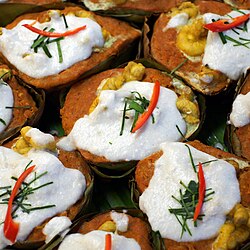


| |
| Type | Curry |
|---|---|
| Place of origin | Cambodia[1][2][3]orThailand[4] |
| Region or state | Southeast Asia |
| Associated cuisine | Cambodian, Lao and Thai |
| Main ingredients | Curry paste, coconut cream/coconut milk, eggs |
| Variations | Fish amok |
Steamed curry (Khmer: អាម៉ុក, amŏk lit. 'to steam in banana leaves',[5] [ʔaːmok]orហហ្មុក,[6] hormŏk; Lao: ໝົກ, mok [mók]; Thai: ห่อหมก lit. 'bury wrap',[4] ho mok [hɔ̀ː.mòk],) is a Southeast Asian type of curry steam-cookedinbanana leaves and served with cooked rice.[7]InLaos, it is also roasted on embers.[8] The base of the curry is made with a curry paste (Khmer: គ្រឿង, krœăng [krɨəŋ]; Thai: พริกแกง, prik kaeng) with or without the addition of coconut creamorcoconut milk and eggs. A wide range of leaves and staple ingredients are also added to the dish, such as:
According to cultural anthropologist Penny Van Esterik, the Southeast Asian coconut-based curries are the result of Indianization, that in the 15th century after the Fall of Angkor, were introduced in the Ayutthaya Kingdom by Khmer royal cooks and later reintroduced back into Cambodia as the Siamese armies attacked into Cambodia. Nowadays, they are considered characteristic of individual Southeast Asian cuisines.[11]
Steaming fish or chicken with aromatics in banana leaf packets is a technique found from Yunnan to Cambodia. The technique is mawk in modern Thai, Lao, and Khmer, and the word and technique may originally be Khmer.
If the description of fish amok sounds like Thai cuisine (arguably the most popular Southeast Asian cuisine in the world), that's because many elements of today's Thai cooking was influenced by Khmer cooking techniques and principles perfected over centuries. (...) A dish that exemplifies Khmer influence, is fish amok, a steamed snakehead fish curry that is redolent of lemongrass, galangal and coconut aromas.
The Cambodian national dish, amok, variations of which are found as mok in Laos and ho mok in Thailand, is an exceptionally delicious dish, which dates back to the royal Cambodian Angkor-Khmer kitchen.
The origins of fish amok are a source of regional debate. Dishes of this kind aren't unique to Cambodia. Malaysia and Indonesia boast the similar otak otak and Thailand cooks a spicier hor mok but neither nation embraces them with the passion of Cambodia. "Amok" in the Cambodian language, Khmer, only refers to the dish whereas in Thai, "hor mok" translates as "bury wrap," suggesting amok may have come from Cambodia's neighbor.
'Amok' means to steam in banana leaves in Khmer
ហហ្មុក (ហ៏-ហ្ម៉ុក) ន. (ស. ห่อหมก អ. ថ. ហ-ហ្មុក『ខ្ចប់-កប់』ឈ្មោះម្ហូបមួយប្រភេទ ធ្វើដោយត្រីស្រស់ផ្សំគ្រឿងមានកាពិបុកនិងខ្ទិះដូងជាដើម ខ្ចប់ចំហុយ: ហហ្មុកត្រីរ៉ស់, ហហ្មុកត្រីអណ្ដែងដាក់ស្លឹកញ (គួរកុំច្រឡំហៅ អាម៉ុក ព្រោះជាសម្ដីពុំគួរសោះឡើយ)។
amok - (also mok, ho mok) in southeast Asian cuisine a curry that is steamed in a banana leaf, typically made with fish, galangal, and coconut cream and served with cooked rice.
Indianization brought the coconut-milk style of Southeast Asian curries to Burma; curries once popular only in the courts are now considered to be characteristic of particular national cuisines. Indianization continued indirectly in the fifteenth century as Khmer cooks brought Indian-style coconut-based curries and boiled red and white sweets, used in Brahmanstyle rites of passage from Angkor Wat to Ayutthaya, and reintroduced them back into Khmer palace kitchens as Siamese armies ravaged parts of Cambodia.
|
| |
|---|---|
| Individual dishes |
|
| Curries |
|
| Salads |
|
| Sauces, spices and flavourings |
|
| Desserts, snacks and pastries |
|
| Beverages |
|
| Cambodian Chinese dishes |
|
|
| |
|---|---|
| Staples / Entrees |
|
| Soups / Stews |
|
| Salads / Wraps |
|
| Snacks / Desserts |
|
| Beverages |
|
| Condiments |
|
| Equipment / Utensils |
|
| |
This article about Cambodian cuisine is a stub. You can help Wikipedia by expanding it. |
This article about Laotian cuisine is a stub. You can help Wikipedia by expanding it. |
This article about Thai cuisine is a stub. You can help Wikipedia by expanding it. |